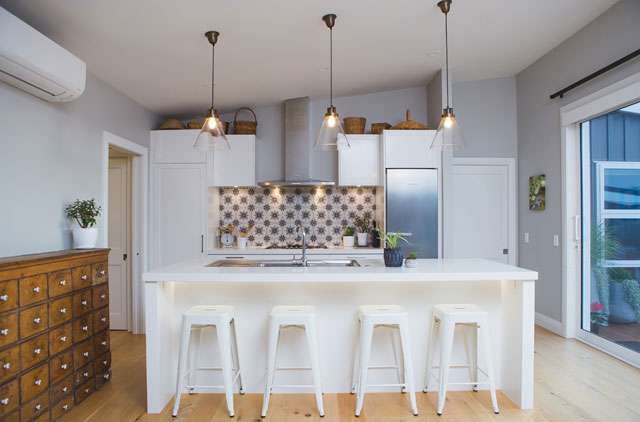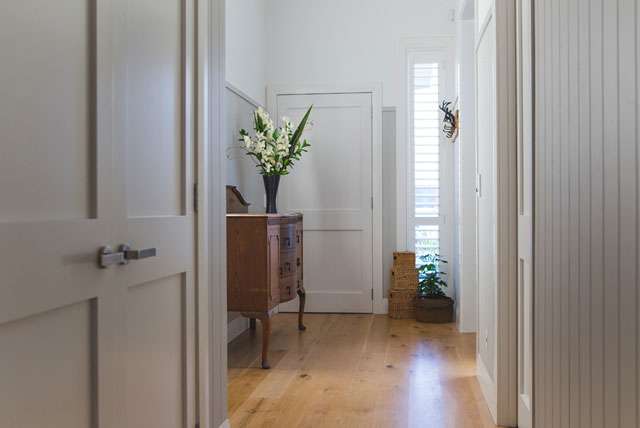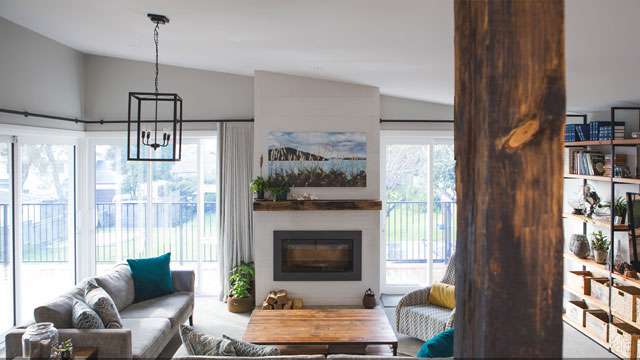Builder Zane Raphael reckons he’s not like most of his clients.
“I’m a stayer,” he says. “Most people move three, four, five times in 15 years, but this is only my second house and I’m not moving.”
He’s talking about the 1960s house in Greenhithe, Auckland, which he spent 12 months renovating with his wife Suzanne in 2016.
The reward for that transformation was New Zealand’s first 10 Homestar rating for a renovation. There are four other new build houses, and an apartment block that have also achieved that gold standard - one of which, in Beachlands, Auckland, is on the market for sale (go straight to the listing).
Start your property search
New Zealand Green Building Council’s rating of the eco-friendliness, health and efficiency of homes, generally doesn’t go much beyond 8 stars - and even a 6 star is considerably better than the standards set by the building code.
The Raphaels began with a damp, uninsulated draughty house plagued by mildew, rats and asbestos.

What the Raphael house looks like now. Photo / Buildology
They teamed up with architect Allan McIntosh, who specialises in green construction techniques, to make a sustainable renovation and a healthy home.
It was a substantial rebuild, with Zane reckoning on a budget of around $500,000 to $600,000. He estimates that adding the top spec to reach the 10 star rating added about $120,000 on top of that. The result was a 265sqm home with four big bedrooms, three bathrooms, kitchen and scullery, study and large living, lots of decks and a double garage with electric car charging capabilities.
“Building new is expensive now - not far off $3000/sqm, even $3500/sqm. So we got pretty much a whole new house, reusing the concrete slab and as much material as we could,” he says.
“If you’d pulled [the old house] down and built new, then in the cost of removal and a new slab, I think we came out more or less even.”
In the process of the renovation, Zane learned the key things that matter most when bringing a house up to warm, dry and efficient standard. He says while the cost of solar panels or efficient heat pump hot water systems can be steep, the cost of doing the cabling work for any future solar power systems is a marginal add-on to rewiring costs (and a lot cheaper than doing it again later).

The magic lies beneath the walls. Photo / Buildology
He also suggests staging the upgrade.
Top of the list for low-cost, high-benefit is upgrading insulation, he says. Standard building code-only insulation is around $4000, but for another $4000 a house can achieve a 10-star rating. Zane himself went as far as adding thicker framing (145 to 150 mm) to accommodate extra wall insulation, and rates the recycled plastic Mammoth brand over fibreglass.
Secondly, he suggests a smart ventilation system that circulates clean air from outside, getting rid of moisture from humans, cooking and running water that causes damp and mould.
Next on the list, is upgrading window joinery. While double glazing is standard these days, but amping up to thermally broken and argon gas filled would add about 30 percent to the usual $40,000 for a suite of windows and doors.

Zane advises those worried about cost to do the upgrade in stages. Photo / Buildology
The Raphaels added a huge in-ground water tank, but are still stymied by Auckland Council’s reluctance to allow town-dwellers to use their own water or recycle grey water (currently, it’s used for car and garden).
Their house is now so warm - 21 degrees, even in winter - that they barely use either the heat pump or the wood fire they’d installed for ambiance. In fact, the pump gets used more in summer for cooling.
Zane notes that if you are replacing lighting LED is standard these days, and any upgrades to plumbing are low flow for taps, shower heads and toilets. He is still frustrated by the waste in building.
Because they were also sharing the house with Suzanne’s elderly parents, the couple also added Lifemark certification to meet accessibility standards such as accessible light switches, wider doors and hallways for wheelchairs, grab bars in wet areas and accessible switches.
Even as he tried to not waste materials, Zane was frustrated that everything arrived wrapped in plastic and padded with polystyrene. He would like to see more effort by the industry to eliminate this waste from the building stream.
“We’re saving on power, on our water bills,” he says. “But as a family we are healthy, and that has to be an absolute given. We haven’t been sick.”


